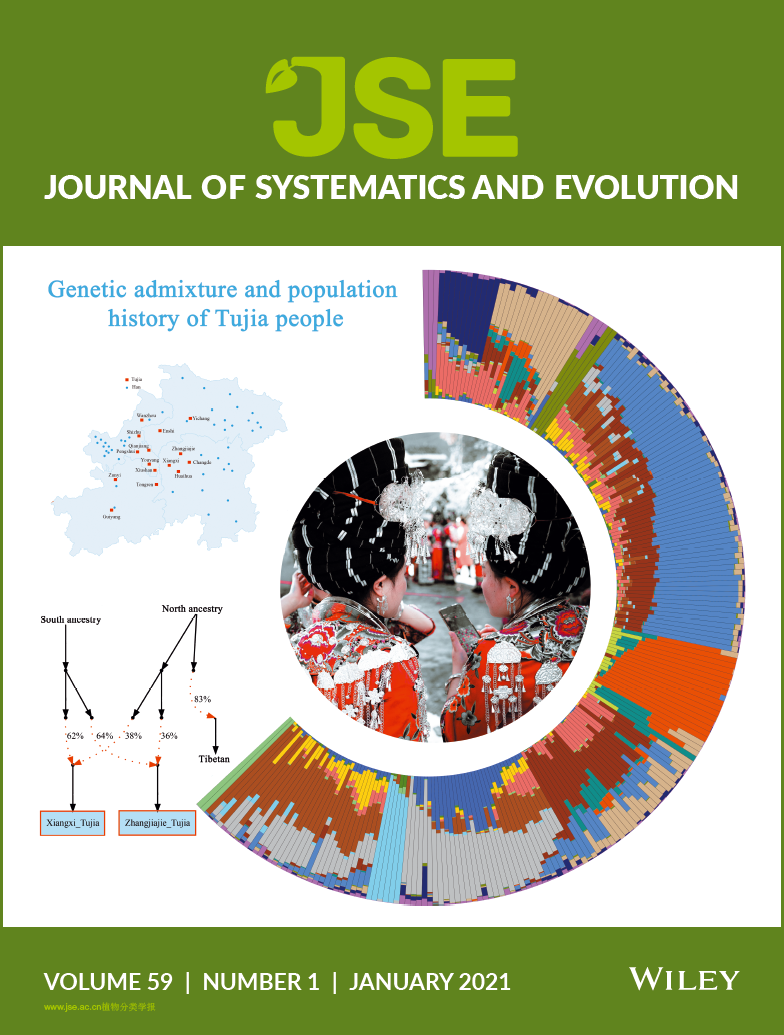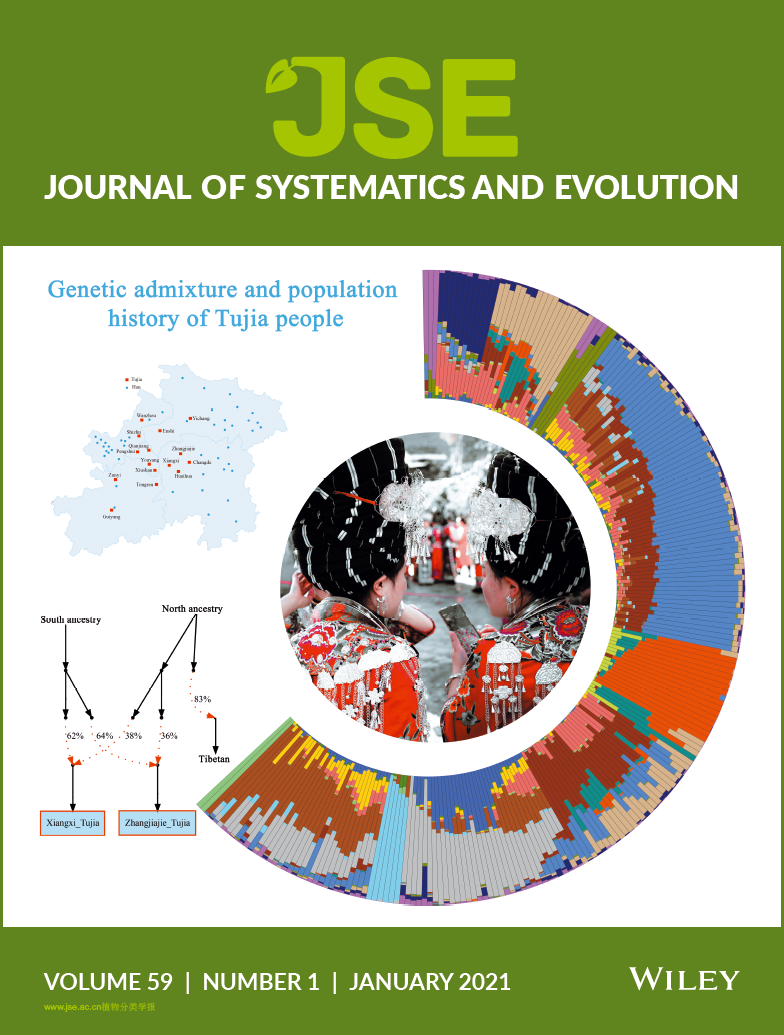


The Journal of Systematics and Evolution would like to acknowledge and thank the following reviewers for their contributions in the period January 1–December 31 in 2020:
Andrés‐Sánchez, Santigo
Antunes Carvalho, Fernanda
Appelhans, Marc
Bachelier, Julien
Bai, Wei‐Ning
Baldwin, Bruce
Banasiak, Lukasz
Bao, Ying
Bard, Nicholas
Benítez Benítez, Carmen
Berry, Paul
Bonifacio de Leon, Mauricio
Bontrager, Megan
Boufford, David
Brandrud, Marie Kristine
Bruederle, Leo
Camara, Paulo
Cameron, Kenneth
Cannon, Chuck
Carta, Angelino
Catherine, Lafarge
Chen, Chun‐Yan
Chen, Hua
Chen, Lei
Chen, Zhi‐Duan
Clark, Lynn
Compton, James
Conran, John
Corlett, Richard
Costa, Suzana
Crane, Peter
Crawford, Daniel
Crespo, Manuel B.
Crowl, A
Davis, Aaron
Davis, Jerrold
De Franceschi, Dario
de Sousa, Philipe
Del Rio, Cédric
Deng, Min
Denk, Thomas
Dickinson, Timothy A.
Dou, Quan‐Wen
Du, Fang
Dupuis, Julian R.
Duvall, Melvin
Ebersbach, Jana
Eder, Johanna
Edera, Alejandro
Elliott, Tammy L.
Eriksson, Torsten
Escudero, Marcial
Evans, Timothy M.
Favre, Adrien
Figlar, Dick
Fior, Simone
Fitzpatrick, Matt
Ford, Bruce
Foster, Charles
Freire, Susana
Freudenstein, John
Friis, Else
Fritsch, Peter
Gao, Lian‐Ming
Ge, Xue‐Jun
Geltman, Dmitry
Gensel, Patricia
Gerrath, Jean
Gillespie, Emily
Givnish, Thomas
Goetghebeur, Paul
Gold, Zack
Gong, Yan‐Bing
Gostel, Morgan
Graham, Sean
Hao, Gang
Harris, AJ
Herendeen, Patrick
Hermsen, Elizabeth
Herrera, Fabiany
Hipp, Andrew
Huang, Chien‐Hsun
Huang, Shuang‐Quan
Huarte, Roberto
Ickert‐Bond, Stefanie
Jiao, Yuan‐Nian
Jiménez‐Mejías, Pedro
Jin, Xiao‐Hua
Jin, Jian‐Hua
Joyce, Elizabeth
Jud, Nathan
Kang, Ming
Karunarathne, Piyal
Kenrick, Paul
Kessler, Michael
Khine, Phyo Kay
Klein, Tamir
Klimešová, Jitka
Klopper, Ronell R.
Knoop, Volker
Kress, John
Kuo, Li‐Yaung
Lakusic, Dmitar
Landis, Jacob
Lashermes, Philippe
Lehnert, Marcus
Lehtonen, Samuli
Levin, Geoffrey
Li, Fay‐Wei
Li, Hui
Li, Jianhua
Li, Lin‐Feng
Li, Sirius
Li, Zhen
Li, Zheng
Li, Zhong‐Hu
Liao, Wan‐Jin
Lin, Zhenguo
Liu, Bing
Liu, Bo‐Ling
Liu, Jian‐Quan
Liu, Juan
Liu, Jun‐Feng
Lu, Li‐Min
Luceño, Modesto
Lunau, K.
Ma, Jian‐Chao
Ma, Tao
Ma, Xiao‐Fei
Mairal Pisa, Mario
Mandel, Jennifer
Manos, Paul
Mao, Jian‐Feng
Mao, Kang‐Shan
Marlien, van der Merwe
Marrano, Annarita
Martín‐Bravo, Santiago
Martinetto, Edoardo
Mathews, Sarah
McLay, Todd
McNeal, Joel
Michelangeli, Fabian A.
Molina Venegas, Rafael
Momohara, Arata
Moody, Michael
Moore, Abigail
Morrone, Juan José
Mu, Xian‐Yun
Naghiloo, Somayeh
Nie, Ze‐Long
Niu, Yang
Nobis, Marcin
Oberprieler, Christoph
Ohlsen, Daniel
Ojeda, Dario
Otero, Ana
Packer, Jasmin
Pais, Andrew
Papini, Alessio
Pedrosa‐Harand, Andrea
Pelser, Pieter
Peterson, Paul
Pigg, Kathleen
Pipes, Leonore
Poschlod, Peter
Potter, Daniel
Qi, Ji
Qian, Hong
Qiu, Ying‐Xiong
Quan, Cheng
Ran, Jin‐Hua
Ree, Richard
Reginato, Marcelo
Ren, Ming‐Xun
Ren, Zong‐Xin
Reznicek, Anton
Riina, Ricarda
Roalson, Eric
Rong, Jun
Röβler, Ronny
Sahu, Sunil Kumar
Salariato, Diego
Salino, Alexandre
Saunders, Richard
Sauvage, Thomas
Sawicki, Jakub
Schneeweiss, Gerald
Schneider, Harald
Schutz, Nicole
Sengupta, Aniket
Shan, Hong‐Yan
Shao, Lisha
Shi, Cheng‐Min
Shi, Gong‐Le
Simon‐Porcar, Violeta
Smýkal, Petr
Søchting, Ulrik
Solis‐Montero, Lislie
Soltis, Douglas
Soltis, Pamela
Song, Yi‐Gang
Soreng, Robert
Sosa, Victoria
Spalink, Daniel
Steinmann, Victor
Storchova, Helena
Stubbs, Rebecca L.
Su, Tao
Su, Xu
Sun, Bai‐Nian
Sun, Fengjie
Sun, Gen‐Lou
Sun, Gui‐Ling
Sun, Hai‐Qin
Sun, Hang
Sun, Jian
Sun, Miao
Sun, Yong‐Shuai
Surget‐Groba, Yann
Susanna, Alfonso
Tate, Jennifer A.
Taylor, Jo
Teixido, Alberto
Tolke, Elisabeth
Toniutti, Lucile
Tosal Alcobé, Aixa
Triplett, Jimmy
Trunschke, Judith
VanWallandael, Acer
Villa, Irene
von Balthazar, Maria
Wade, Rachael
Walker, Joseph F.
Wang, Bao‐Sheng
Wang, Hong
Wang, Jing
Wang, Jun
Wang, Li
Wang, Nian
Wang, Qing‐Feng
Wang, Wei
Wang, Yin‐Zheng
Wang, Ying‐Qiang
Wang, Yu‐Fei
Wang, Yu‐Guo
Wang, Ze‐Fu
Wang, Zhi‐Heng
Wanke, Stefan
Waterway, Marcia
Wei, Ran
Wei, Xin‐Li
Wester, Petra
Westerberg, Lars
Westergaard, Kristine
Weston, Peter
Wilson, Andrew
Wilson, Barbara
Wilson, Paul
Wojciechowski, Martin
Wu, Zhi‐Qiang
Xiang, Chun‐Lei
Xing, Yao‐Wu
Xu, Qing
Xu, Shu‐Hua
Xu, Xiao‐Ting
Yabe, Atsushi
Yan, Hai‐Fei
Yan, Yue‐Hong
Yang, Hai‐Ling
Yang, Ji
Yang, Jun
Yang, Melinda
Yang, Shi‐Xiong
Yang, Ze‐Feng
Ye, Qing
Yesilyurt, Jovita
Yi, Ting‐Shuang
Yu, Wen‐Bin
Yu, Yan
Zander, Richard
Zavada, Michael
Zavialova, Natalia
Zeng, Qing‐Yin
Zeng, Yan‐Fei
Zhang, Hai‐Qing
Zhang, Jian‐Qiang
Zhang, Jin‐Long
Zhang, Kai‐Mei
Zhang, Li‐Bing
Zhang, Shu‐Ren
Zhang, Ti‐Cao
Zhang, Wenheng
Zhang, Wen‐Ju
Zhang, Wen‐Xia
Zhang, Xiao‐Ming
Zhang, Yu‐Xiao
Zhang, Zhen‐Hua
Zhang, Zhi‐Yong
Zhao, Yun‐Peng
Zhou, Ren‐Chao
Zhu, An‐Dan
Zhu, Shan‐Shan
Zuluaga, Alejandro